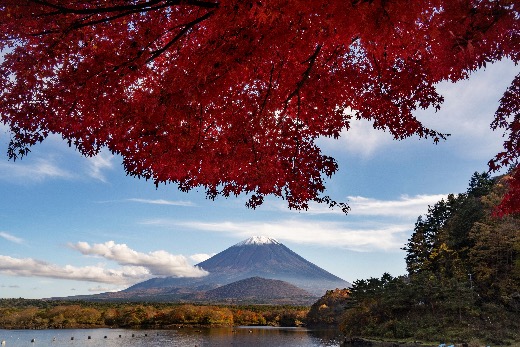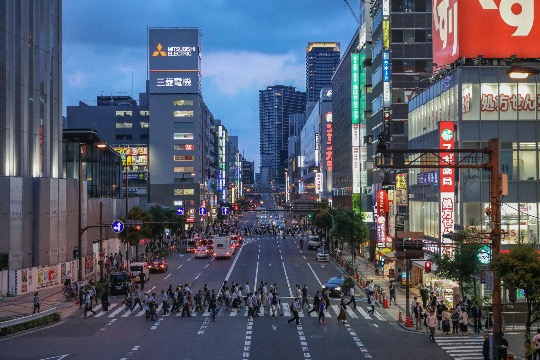
Exploring Tokyo Vol. 2: The Hidden Gems of Tokyo’s Periphery
Moving from Tokyo’s center to its periphery, the city’s bustle tranquilizes and begins to reveal its hidden gems of which otherwise would not have been seen. When many interns begin their travels, they find their comfort zone in familiar areas, and forget that there’s so much more to see! From the historical significance and commercial vitality of Nakano Broadway Shōtengai to the European-esque beauty of Jiyūgaoka to the languid beauty of Inokashira Park’s Ghibli Museum, there’s still so much to see! Luckily, your internship in this amazing country will give you lots of time to explore, wander and soak up the best of Japan! Continuing Zentern’s masterlist of must-see spots in Tokyo, we’re looking at places outside Tokyo’s center!
Sumida-ku - Tokyo Sky Tree

Tokyo Skytree: Constructed over a period of three years, the Tokyo Skytree was named the tallest tower in the world in 2011 and it is currently ranked the third tallest structure in the world. The tower is also the primary television and broadcast tower in the Kantō region. The nightly illuminations seen when gazing upon the tower alternate daily between blue and purple.
Sumida River Walk: Meandering toward Tokyo Bay, the Sumida River provides refuge from the metropolitan environment, lined with stores and seating areas. The Tokyo Mizumachi shopping complex can be found along the river walk which includes cafés and restaurants where you can enjoy the river’s majesty.
Sumida-Hokusai Museum: Arguably the most renowned and well-known Japanese artists, Hokusai, responsible for the ‘The Great Wave off Kanagawa,’ was an ukiyo-e painter from the Edo-era. The Sumida-Hokusai Museum, within its modernist edifice, is dedicated to displaying the works of Hokusai and his disciples. There are also seasonal exhibitions which aim to educate the public about Edo-era ukiyo-e. Within the museum is a gift shop where you can peruse books about contemporaneous art and history.
Asakusa, Taito-ku - a city full of history!

Asakusa’s Nakamise Shopping Street: A picturesque traditionalist market leading toward Sensoji Temple, Nakamise Shopping Street is believed to originate from the 17th century when the locality was given permission to open shops on temple grounds. As such the market has been rebuilt twice, after the Kanto Earthquake of 1923 and the World World 2 firebombings. At this market, you can find speciality street-food and traditional clothing and accessories. If you’re looking for kitschy souvenirs to commemorate your sprouting career in Tokyo, this is the perfect market!
Sensoji Temple: One of the most visited temples in Japan, it has attracted tourists with its crimson, ornate façade. Sensoji Temple is also the oldest Buddhist temple within the capital. The large lantern hung is inscribed with the kanji Kamnarimon, in reference to the temple’s worshiped god.
Asahi Beer Tower: One of Asakusa’s most recognizable buildings, the Asahi Beer Tower is christened with a neon-yellow structure dubbed the ‘Asahi Flame,’ which was designed by French Architect Phillippe Starck. If you’re interested in one of Japan’s most famous breweries, the building contains drinking facilities featuring original craft beers!
Nakano-ku - perfect for manga and anime lovers!

Nakano Broadway Shōtengai: Although a slight journey from Tokyo’s center, Nakano Broadway is one of the most beloved destinations by manga and anime lovers. Constructed as a way to redevelop Japan’s post-war economy, the shopping street contains a diverse array of shops and street-food kiosks, all covered by a concave sun-roof. However, many of these shops feature vintage anime and manga, collectables, video games and old CDs and vinyls.
Tetsugakudo-koēn: Tetsugakudo-koēn is a unique park commissioned in the beginning of the 20th century by the philosopher and founder of Toyo University, Inoue Enryō. The parks features and fixtures are all named in commemoration of the greatest Eastern and Western philosophers to date. It’s worth a visit upon your departure from Nakano Broadway.
Meguro-ku - where the locals live and relax

Meguro Sky Garden: Surely one of Tokyo’s most unique parks, Meguro Sky Garden is a 9th-story heavenly garden situated atop a motorway interchange. There are over 1,000 sakura and pine trees along with a vegetable garden and a children’s playground. When leaving Ikejiri-Ōhashi station, take the south exit to ‘Meguro Sky Garden!’
Naka-meguro: Within the center of Meguro-ku is a vibrant district which infuses the beauty of a luxurious residential area into the commercial bustle that Tokyo is known for. When exiting the train at Naka-meguro station, the wafting smell of fresh ramen and yakitori is detectable from the Izakaya below, at the station’s base. Further, there are restaurants found across the main street and along Meguro River. At night, many fashionable Tokyoites congregate in Naka-meguro for their upscale bars and clubs.
Jiyūgaoka: An often disregarded neighborhood bordered between Meguro and Setagaya, Jiyūgaoka emulates the feel of an atypical European city, whilst still maintaining that distinct Tokyo flair. With curated boutiques, foreign-cuisine restaurants and a giant supermarket with imported foods, Jiyūgaoka transports you back home. If you’re looking for a French boulangerie, they’re found speckled along the streets of Jiyūgaoka. Further, during the summer, you can take a gondola ride, simulating a true Venetian experience.
Setagaya-ku - a place full of temples

Shimokitazawa: Taking the Inokashira line from Shibuya Station, you’ll quickly find yourself in a uniquely youth-cultured area. Shimokitazawa is seemingly built for fashion, with independent vendors with unique brands, both luxury and cult-classic, all across the neighborhood. On weekends, you can find a huge market upon exiting the station. Further, with trendy restaurants and jazz bars, you can spend a full-day’s time in Shimokitazawa, and not feel the time pass.
Gotokuji Temple: Acting as the burial grounds of Ii Clan in the Edo-era, Gotokuji is now regarded as the ‘cat temple,’ with regard to the maneki-neko, or cat statues, along the temple's ground. Emulating a calico Japanese bobtail, these statues are meant to bring luck to visitors of the temple.
Koenji: A unique district, often untravelled by tourists, Koenji served as the nesting-place which nurtured the Japanese punk scene during the 1970’s. As such, you can find bohemian-style restaurants and bars all across the neighborhood. Koenji is also regarded as a thrifting paradise, with second-hand shops selling memorabilia from the 1970’s and 1980’s, and brand-name goods for a fair price.
Yokohama - Port City

Yokohama Chinatown: The largest Chinatown in Japan, it’s humble beginnings in the 19th century have developed into a must-see tourist spot. Although not many Chinese live there today, its heritage lives on through the various Chinese-themed shops and cuisine found sprawling around the large-area covered by Yokohama’s Chinatown.
Yokohama Red Brick Warehouse: Constructed originally as a harbor facility around the Port of Yokohama, impressive and conservative architectural style coupled with its striking red color, it has become a recognizable structure for visitors and Yokohama natives. During the holidays, the Yokohama Red Brick Warehouse is used to showcase a Southern German-esque Christmas market.
Cosmo World: Yokohama Cosmo World is an amusement park rivaling Tokyo Disney. It is home to the Cosmo Clock 21 which was named the tallest Ferris Wheel in the world until it was superseded by Igosu 108 in 1992. It has become a nostalgic destination of Yokohama for family visits and romantic outings. The park is unique in that there are no entrance fees, but fees for individual rides.
Tokyo: A Thrilling Destination for Your Internship Adventure
Tokyo is a city like no other, a mesmerizing blend of ancient traditions, futuristic innovation and delicious food! From its busy neon-streets and dazzling skyscrapers to its serene parks and sacred temples, Tokyo offers an unparalleled experience that combines culture, cuisine, and excitement. Whether you're navigating the iconic Shibuya Scramble, exploring the historic alleys of Omoide Yokocho in Shinjuku, or soaking in the beauty of sakura at Shinjuku-gyoen, every corner of this metropolis holds a story waiting to be discovered.
Choosing Tokyo as the destination for your internship means immersing yourself in a vibrant city that inspires creativity, fosters growth, and leaves an indelible mark on your journey.
The Zentern Program offers you the opportunity to not only advance your career but also create memories in one of the most dynamic cities in the world.
Don’t just visit Tokyo, live it! Apply now for the Zentern Program and embark on an adventure of a lifetime.







